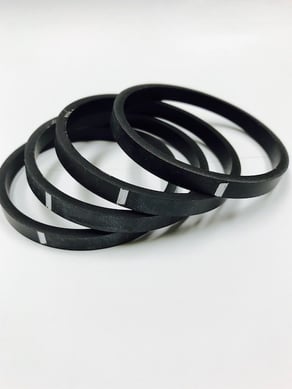
Choosing a sealant is one of the most important aspects of creating functionality and sustainability in your industrial and commercial products. Choosing the correct sealing solution is essential to keep debris out of your machinery and provide resistance to wear and tear. There are many sealing options available on the market including lathe cut gaskets, O-rings, quad seals, and die cut gaskets. In today’s blog, learn what lathe cut gaskets are, how they differ from O-Rings and quad seals, and how they benefit your products and machinery.
Related Post: Lathe Cut Gaskets vs. O-rings-- One in the Same or Wildly Different?
What Are Lathe Cut Gaskets?
Lathe cutting is a method of producing high-quality and more precise gaskets by putting a tube on a mandrel, rotating it at a high speed, and cutting out the dimensions with a knife. Lathe cut gaskets offer the most cost-effective performance and benefits in many circumstances. In static applications specifically, lathe cut gaskets are typically the best option. Lathe cut gaskets have a square or rectangular cross-section, which allows for a much wider sealing surface in comparison to molded gaskets, seals or O-rings.
Watch this video to see our lathe cut gasket manufacturing process
How do Lathe Cut Gaskets Compare to O-Rings And Other Seals?
The most significant difference between lathe cut gaskets and other gaskets or seals lies in the process by which they are made. The lathe cutting process allows for more precise measurements and dimensions, allowing for custom materials, specifications and sizes to be achieved.
Often times, lathe cut gaskets are less expensive than O-Rings and quad seals, especially when ordered in large quantities. Lathe cut manufacturers can extrude sizes from .250” to 7.75”, whereas O-Ring and gasket manufacturers using a molded process, only typically have molds for standard sizes, such as .500” to 3.00” ID. When a larger ID is required, they most likely would have to develop a mold, which can be very costly.
How Flexible is the Design Process?
Lathe cut gaskets require little to no tooling and therefore, have a quicker turnaround than molded gaskets, O-rings and seals. Molded gaskets take longer to develop when a custom mold is required. Unlike in the lathe cut development process where tweaks can easily be made, if a mold’s specifications are off even slightly, the mold must be scrapped and you’re back to square one.
The die cut gasket process also comes with its own complications. The design process for die cut gaskets is based on the thickness of the sheet of material. Special custom thicknesses can be costly depending on the size and tolerance you require. Tooling cost for die, while cheaper than molded gaskets, take significant time to develop. Check out our Custom Rubber Gasket Design Guide to learn everything you need to know about the lathe cut gasket process.
Why Should I Choose Lathe Cut?
Generally speaking, lathe cut gaskets are a less expensive replacement for an o-ring or other squeeze type molded seals and are utilized in virtually every industry. Lathe cut gaskets provide more flexibility in shapes and sizes, making them more versatile for those seeking a non-traditional custom gasket. Lathe cut gaskets typically have a higher turn around than other seals, gaskets, or O-rings because little to no tooling is required. Our lathe cut customers love that the turnover ratio our lathe cut gaskets is typically 2-3 weeks! Check out The Top 5 Reasons to Choose Lathe Cut Gaskets for Your Next Application for more information on the advantages of the lathe cut process.

